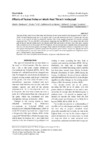Identificador persistente para citar o vincular este elemento:
https://accedacris.ulpgc.es/jspui/handle/10553/25128
| Campo DC | Valor | idioma |
|---|---|---|
| dc.contributor.author | Stanković, M. | en_US |
| dc.contributor.author | Perić, D. | en_US |
| dc.contributor.author | Ruiz-Llamas, Guillermo | en_US |
| dc.contributor.author | Quiroga-Escudero, Miriam E. | en_US |
| dc.date.accessioned | 2018-01-16T03:30:25Z | - |
| dc.date.accessioned | 2018-03-15T14:37:42Z | - |
| dc.date.available | 2018-01-16T03:30:25Z | - |
| dc.date.available | 2018-03-15T14:37:42Z | - |
| dc.date.issued | 2017 | en_US |
| dc.identifier.issn | 1646-107X | en_US |
| dc.identifier.uri | https://accedacris.ulpgc.es/handle/10553/25128 | - |
| dc.description.abstract | The aim of this study was to determine the influence of new rules tested at the inaugural Men’s Under 23 (U23) World Championship (set to 21 points and 15 seconds between the end of a point and the new serve) on all aspects of time in volleyball matches. The study sample comprised 36 matches partially segmented into 123 sets and 4583 points played. Applying one-way ANOVA, it was shown that the active part of the set and the whole match last slightly more than one third of the total time. The most frequent rally duration was 5 to 10 seconds (43.5% of points). As sets became more unpredictable and approached the end, rest time between points was longer. Time analysis of volleyball matches is important as it helps with proper development of physical preparation for players, gives coaches insight into appropriate match flow and provides a clear time frame of each part of a volleyball match for organisers of competitive events, pools, championships and tournaments. | en_US |
| dc.format | application/pdf | es |
| dc.language | eng | en_US |
| dc.relation.ispartof | Motricidade | en_US |
| dc.rights | by-nc-nd | es |
| dc.source | Motricidade [ISSN 1646-107X], v. 13 (3), p. 13-21 | en_US |
| dc.subject | 241106 Fisiología del ejercicio | en_US |
| dc.subject.other | Elite male volleyball | en_US |
| dc.subject.other | Match duration | en_US |
| dc.subject.other | Set phases | en_US |
| dc.subject.other | Rally duration | en_US |
| dc.subject.other | Time | en_US |
| dc.title | Effects of tested rules on work-rest time in volleyball | en_US |
| dc.type | info:eu-repo/semantics/Article | en_US |
| dc.type | Article | en_US |
| dc.identifier.doi | 10.6063/motricidade.8990 | |
| dc.identifier.scopus | 85037369050 | |
| dc.contributor.authorscopusid | 56335906800 | |
| dc.contributor.authorscopusid | 57210654018 | |
| dc.contributor.authorscopusid | 56335912100 | |
| dc.contributor.authorscopusid | 55318863300 | |
| dc.identifier.crisid | -;-;66;1833 | - |
| dc.identifier.eissn | 2182-2972 | - |
| dc.description.lastpage | 21 | - |
| dc.identifier.issue | 3 | - |
| dc.description.firstpage | 13 | - |
| dc.relation.volume | 13 | - |
| dc.investigacion | Ciencias de la Salud | en_US |
| dc.rights.accessrights | info:eu-repo/semantics/openAccess | en_US |
| dc.type2 | Artículo | en_US |
| dc.identifier.external | 66;1833 | - |
| dc.date.coverdate | Enero 2017 | |
| dc.identifier.ulpgc | Sí | es |
| dc.description.sjr | 0,192 | |
| dc.description.sjrq | Q3 | |
| item.grantfulltext | open | - |
| item.fulltext | Con texto completo | - |
| crisitem.author.dept | GIR Praxiología motriz, entrenamiento deportivo, didáctica de las actividades físicas y salud | - |
| crisitem.author.dept | Departamento de Educación Física | - |
| crisitem.author.dept | GIR Praxiología motriz, entrenamiento deportivo, didáctica de las actividades físicas y salud | - |
| crisitem.author.dept | Departamento de Educación Física | - |
| crisitem.author.orcid | 0000-0003-1898-0548 | - |
| crisitem.author.orcid | 0000-0002-9641-1183 | - |
| crisitem.author.parentorg | Departamento de Educación Física | - |
| crisitem.author.parentorg | Departamento de Educación Física | - |
| crisitem.author.fullName | Ruiz Llamas, Guillermo | - |
| crisitem.author.fullName | Quiroga Escudero, Miriam Esther | - |
| Colección: | Artículos | |
Citas SCOPUSTM
2
actualizado el 08-jun-2025
Visitas
216
actualizado el 18-may-2024
Descargas
202
actualizado el 18-may-2024
Google ScholarTM
Verifica
Altmetric
Comparte
Exporta metadatos
Los elementos en ULPGC accedaCRIS están protegidos por derechos de autor con todos los derechos reservados, a menos que se indique lo contrario.
